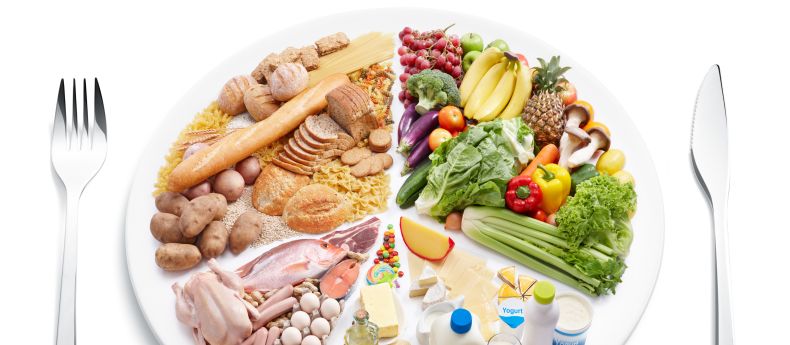
What’s on Your Plate?
While we all have a basic understanding of nutrition, it is nice to remind ourselves how we can eat to optimize health. Eating from all the food groups—fruits and vegetables, whole grains, low-fat dairy and lean protein—is a good way to achieve nutritional balance. This holds true whether you are a child, teen or adult.
Basic guidelines for food choices (compiled with info from the US Department of Agriculture at www.choosemyplate.gov):
- Fill half your plate with fruits and vegetables. Choose from a variety of different fruits and veggies, and buy in season. The more colorful the plate, the better! Fresh, frozen and canned versions also count. Canned food may be rich in sodium, so buy low-sodium versions if available. If you opt for juice, look for 100% fresh juice instead of watered-down, sugary, fruit-flavored drinks.
- Make at least half your grains whole. Look for whole-grain versions of your grain staples at the grocery store. Brown and wild rice are healthy alternatives to white rice. Whole-grain breads, pastas, buns and noodles will provide the energy and fiber you need throughout the day.
- Switch to skim or low-fat dairy products. Fat-free and low-fat dairy products provide the same amount of calcium, protein and other essential nutrients as whole-fat dairy without the artery-clogging side effects.
- Vary your protein. Try lean cuts of meats and poultry, and don’t forget to trim any visible fat prior to cooking. Eating fish and seafood twice a week provides omega-3 fats, which are essential for heart and brain health. Vegetarian options include eggs, beans, soy, tofu and nuts. With those options to choose from, try going vegetarian once a week!
Keeping these tips in mind, let’s try grading a few popular school lunch options.
1) Fish sticks Fish sticks generally refer to fish fillets battered in bread crumbs and baked or fried. The type of fish is generally minced white fish but can also include other varieties such as salmon. The main determinant of its health quality is its method of preparation. The deep-fried version contains unnecessary trans fats, which are known to clog arteries. Baked fish sticks are the best option because additional fat is rarely added to the fish when baking. A school lunch serving may contain three to five fish fingers.
Bottom line: Fish sticks can be a good source of protein and heart-healthy fats (omega-3 fats), but steer clear if they are fried as they add unwanted calories and trans fats to your child’s diet. When coupled with whole grains, fruits and vegetables, fish sticks can be part of a healthy diet. Grade: B
2) Boxed fruit juice Boxed juices, in general, are OK in moderation. They can be a good source of vitamin C and other nutrients if the preparation is undiluted (look for boxes that have “100% juice” on the label). However, many juices may also contain added sugars and are devoid of fiber. Studies suggest that a moderate intake of 100% fruit juice does not affect a child’s weight. However such juices still might contain significant calories just like any other food or calorie-containing drink, meaning too much can contribute to unwanted weight gain. To ensure that your child isn’t drinking too much juice, follow these limits from the American Academy of Pediatrics and the American Heart Association:
- Birth to 6 months: No fruit juice unless it’s used to relieve constipation
- 6 months to 6 years: 4 to 6 ounces (118 to 177 milliliters) a day
- 7 years and older: 8 to 12 ounces (237 to 355 milliliters) a day
Bottom line: 100% juice is OK in moderation, but whole fruits are best. Grade: B
3) Ham and cheese sandwich Sandwiches are a great option for lunch. Ideally, a heart-healthy sandwich is filled with lean meat or vegetable protein (e.g. soy patties or low-fat cheese), veggies (such as lettuce, tomatoes and cucumbers) and a light dressing (such as olive oil or light mayonnaise). Whole-grain breads, pitas and wraps provide an extra boost in fiber, vitamins and minerals. Ham and cheese can be healthy, provided they are low in fat. Lean ham, chicken breast, roast beef and turkey breast are great protein options. Regular ham and whole-fat cheeses are high in saturated fats. Consuming a lot of saturated fats may ultimately increase your cholesterol.
Bottom line: Plain ham and cheese sandwiches are probably high in saturated fats. Opt for lean versions of your deli meats and top off your sandwiches with low-fat cheese. Throw in some veggies for some added vitamins and crunch Grade: B-
4) Chinese meatballs Chinese meatballs are usually made with ground pork and cooked in oil. Unless otherwise specified, ground pork tends to be marbled and high in saturated fat. Cooking oil varies from salad oil to sunflower oil. The best heart-healthy oil, canola (rapeseed) oil, is rarely used. Half of the total calories from an average Chinese meatball comes from saturated fat.
Bottom line: Lean cuts of pork—such as pork tenderloin—can be ground to make a healthier meatball. Choosing canola oil and limiting the total amount of oil used can help avoid unwanted calories. The average Chinese meatball is too high in fat to be healthy. Grade: C
5) Stir-fried Chinese vegetables Stir fried veggies prepared outside the home tend to be laden with oil and salt. While veggies should ideally comprise 25% of your and your child’s plate, the amount of oil and salt should be kept to a minimum. In some cases, monosodium glutamate (MSG) is also added. MSG is considered “safe” for consumption in the U.S., but some people may experience side effects after ingestion.
Bottom line: Veggies are great, but excessive oil and salt are not. Ideally, stir-fried veggies are prepared with small amounts of oil and salt. Long-term consumption of oily foods can lead to unwanted weight gain. Grade: B
School lunches offer a wide variety of choices. While we covered some of the more common selections, it is important to note that side entrees and other add-ons can make for an overall healthy lunch. Look for side salads, fresh fruits and low-fat dairy to complement your main dish. Try your best to mimic “My Plate” (www.choosemyplate.gov) and you are well on your way to healthy eating!
Copyright United Family Healthcare 2014 All right reserved - 京卫网审[2014]第1927号 - 京ICP备13017554号-4




